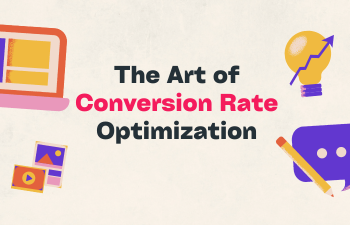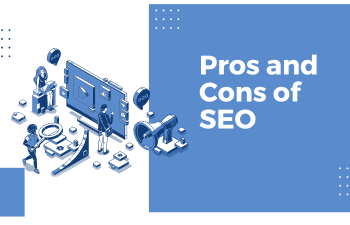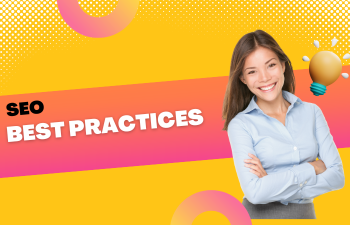Why seo is important for your website?
SEO (Search Engine Optimization) is important for websites because it helps to improve the visibility and ranking of your website in search engine results pages (SERPs). This is important because it can lead to more traffic and visibility for your website, which can ultimately lead to more sales or conversions for your business.
Here are some specific reasons why SEO is important for your website:
Increased traffic: SEO can help to increase the number of visitors to your website by improving its ranking in search engine results. This can lead to more qualified traffic, as people who search for specific terms are more likely to be interested in your products or services.
Higher conversion rates: SEO can also help to improve the conversion rate of your website by making it easier for people to find and navigate. If your website is easy to use and provides valuable information, visitors are more likely to take the desired action (such as making a purchase or filling out a form).
Better user experience: SEO can help to improve the user experience of your website by making it faster and easier to navigate. This can lead to higher satisfaction and engagement levels, which can ultimately lead to more sales or conversions.
Increased credibility: A well-optimized website can also help to improve the credibility and authority of your business. When your website appears at the top of search results, it can give the impression that your business is a trusted and reliable source of information or products.
Overall, SEO is important for your website because it can help to drive traffic, improve conversion rates, enhance the user experience, and increase credibility.
How SEO Increases traffic: for your website?
SEO can increase traffic to your website by improving the visibility and ranking of your website in search engine results pages (SERPs). When your website appears higher in the search results, it is more likely to be seen by users, which can lead to an increase in traffic.
Here are some specific ways that SEO can increase traffic to your website:
Keyword optimization: By including relevant keywords in your website’s content and metadata (such as the title and description tags), you can make it more likely that your website will rank for those terms in search results. This can help to attract more qualified traffic to your website.
On-page optimization: By optimizing the content and structure of your website’s pages, you can make it more likely that your website will rank well in search results. This includes things like using header tags, formatting text, and including internal and external links.
Technical optimization: There are also technical factors that can impact the visibility of your website in search results. For example, making sure your website is mobile-friendly and loads quickly can improve its ranking and make it more attractive to search engines.
Off-page optimization: Off-page optimization refers to the strategies and techniques used to improve the visibility and authority of your website through external means. This can include building backlinks from other websites, as well as engaging in social media marketing and other forms of online promotion.
Overall, by optimizing your website and using various SEO techniques, you can increase its visibility and ranking in search results, which can ultimately lead to an increase in traffic.
How higher conversion rate achieved while doing SEO ?
SEO can help to improve the conversion rate of your website by making it easier for users to find and navigate. When your website is optimized for search engines, it is more likely to rank well in search results and be seen by users who are looking for the products or services you offer. This can increase the likelihood that visitors will take the desired action, such as filling out a form or making a purchase.
Here are some specific ways that SEO can improve the conversion rate of your website:
Keyword optimization: By including relevant keywords in your website’s content and metadata, you can make it more likely that your website will rank for those terms in search results. This can help to attract more qualified traffic to your website, which is more likely to convert.
On-page optimization: By optimizing the content and structure of your website’s pages, you can make it easier for users to find and navigate your website. This includes things like using clear and descriptive headings, formatting text for readability, and including calls to action.
Technical optimization: There are also technical factors that can impact the conversion rate of your website. For example, making sure your website loads quickly and is mobile-friendly can improve the user experience and make it more likely that visitors will stay on your website and take the desired action.
Landing page optimization: Your website’s landing pages, in particular, play a key role in the conversion process. By optimizing your landing pages for both search engines and users, you can increase the likelihood that visitors will take the desired action. This can include things like including a clear and compelling call to action, using persuasive copy, and including social proof (such as customer testimonials).
Overall, by optimizing your website for search engines and users, you can improve the conversion rate of your website by making it easier for visitors to find and navigate, and by providing a positive and persuasive user experience.
On Page Optimization in SEO ?
On-page optimization refers to the strategies and techniques used to optimize individual web pages in order to rank higher in search engine results and earn more relevant traffic. On-page optimization involves making changes to the content and HTML source code of your website’s pages.
Here are some specific on-page optimization techniques you can use to improve your website’s ranking and visibility in search results:
Use relevant and targeted keywords: By including relevant keywords in your website’s content and metadata (such as the title and description tags), you can make it more likely that your website will rank for those terms in search results.
Use header tags: Header tags (such as H1, H2, and H3) help to structure the content of your website and make it easier for both users and search engines to understand the main topics and subtopics on your pages.
Format text for readability: By using formatting techniques such as bolding, italicizing, and using bullet points, you can make your content easier to read and more appealing to users.
Include internal and external links: Internal links, which link to other pages on your website, can help search engines to understand the structure and hierarchy of your website. External links, which link to other websites, can help to demonstrate the authority and credibility of your website.
Use alt tags: Alt tags are short descriptions that are added to images to describe their content. They are important for SEO because they help search engines to understand the content of your images and can be used to rank your images in image search results.
Overall, on-page optimization involves making changes to the content and HTML source code of your website’s pages in order to improve its visibility and ranking in search results.
What is off page seo ?
Off-page optimization, also known as off-site optimization, refers to the strategies and techniques used to improve the visibility and authority of your website through external means. Off-page optimization involves activities that take place outside of your website and are used to improve its ranking and visibility in search results.
Here are some specific off-page optimization techniques you can use to improve your website’s ranking and visibility in search results:
Link building: Link building involves acquiring links from other websites to your own. Search engines use links to understand the relevance and authority of your website, so the more high-quality links you have pointing to your site, the more likely it is to rank well in search results.
Social media marketing: By promoting your website and content on social media platforms, you can increase its visibility and drive traffic to your website.
Content marketing: By creating and promoting valuable and relevant content, you can attract more visitors to your website and improve its ranking in search results.
Local SEO: If you have a local business, you can use local SEO techniques to improve your website’s visibility in search results for local searches. This can include optimizing your website for local keywords and including your business’s name, address, and phone number (NAP) on your website and in online directories.
Overall, off-page optimization involves activities that take place outside of your website and are used to improve its ranking and visibility in search results. These activities can include link building, social media marketing, content marketing, and local SEO.
Technical optimization in seo ?
Technical optimization refers to the strategies and techniques used to optimize the technical aspects of a website in order to improve its ranking and visibility in search results. Technical optimization involves making changes to the underlying code and structure of a website in order to make it more attractive to search engines and easier for users to navigate.
Here are some specific technical optimization techniques you can use to improve your website’s ranking and visibility in search results:
Website speed: Search engines favor websites that load quickly, so it’s important to optimize your website for speed. This can involve optimizing images, minifying CSS and JavaScript files, and using a content delivery network (CDN).
Mobile-friendliness: More and more users are accessing the internet from mobile devices, so it’s important to make sure your website is mobile-friendly. This can involve using responsive design techniques and testing your website on different devices and screen sizes.
XML sitemaps: An XML sitemap is a file that lists all the pages on your website and provides additional information about each page to search engines. XML sitemaps can help search engines to discover and crawl your website more efficiently.
Robots.txt file: The robots.txt file is a file that tells search engines which pages or files they should not crawl. By including a robots.txt file on your website, you can prevent certain pages or files from being indexed in search results.
Canonical tags: A canonical tag is an HTML tag that is used to indicate the preferred version of a webpage. It can be used to prevent duplicate content issues and ensure that search engines are only indexing the most relevant version of a webpage.
Overall, technical optimization involves making changes to the underlying code and structure of a website in order to improve its ranking and visibility in search results. This can include optimizing for website speed, mobile-friendliness, and other technical factors.
Landing page optimization:
Landing page optimization refers to the strategies and techniques used to improve the performance of a website’s landing pages. A landing page is the specific page on your website where users land after clicking on a search engine result or advertisement. Landing pages are important because they play a key role in the conversion process – they are the first point of contact between your business and a potential customer.
Here are some specific landing page optimization techniques you can use to improve the performance of your website’s landing pages:
Use a clear and compelling call to action: The call to action (CTA) is the main message or action that you want visitors to take on your landing page. It should be clear, concise, and persuasive.
Use persuasive copy: The copy on your landing page should be compelling and persuasive, and should focus on the benefits of your products or services rather than just the features.
Include social proof: Social proof, such as customer testimonials or reviews, can help to increase the credibility and persuasiveness of your landing page.
Use images and videos: Visual elements, such as images and videos, can help to engage users and make your landing page more attractive and persuasive.
Use A/B testing: A/B testing involves creating two versions of your landing page and testing them against each other to see which performs better. This can help you to identify which elements of your landing page are most effective and make informed improvements.
Overall, landing page optimization involves making changes to the design and content of your landing pages in order to improve their performance and increase the likelihood that visitors will take the desired action.
Is SEO needed for your website ?
Whether or not SEO is needed for your website depends on your business goals and target audience. If you want to attract more traffic and visibility to your website, and if your target audience uses search engines to find products or services like yours, then SEO can be an effective way to achieve those goals.
SEO can be particularly important for small businesses and websites that are just starting out, as it can help to establish credibility and visibility in a crowded online marketplace. It can also be helpful for established businesses that want to maintain or improve their ranking and visibility in search results.
However, if your target audience does not use search engines to find products or services like yours, or if you are already receiving a sufficient amount of traffic and conversions from other sources, then SEO may not be as important for your website.
Overall, SEO can be an effective way to improve the visibility and ranking of your website in search results, which can lead to more traffic and sales. However, whether or not it is needed for your website depends on your business goals and target audience.

 Digital Marketing
Digital Marketing




















